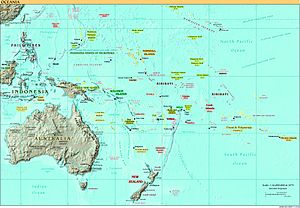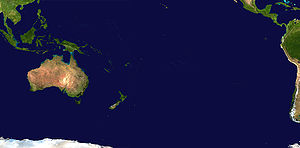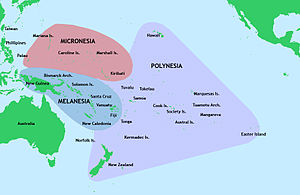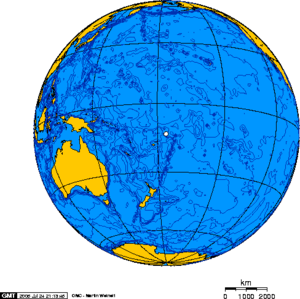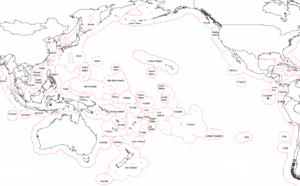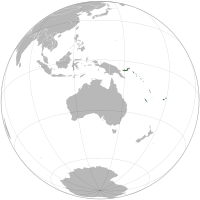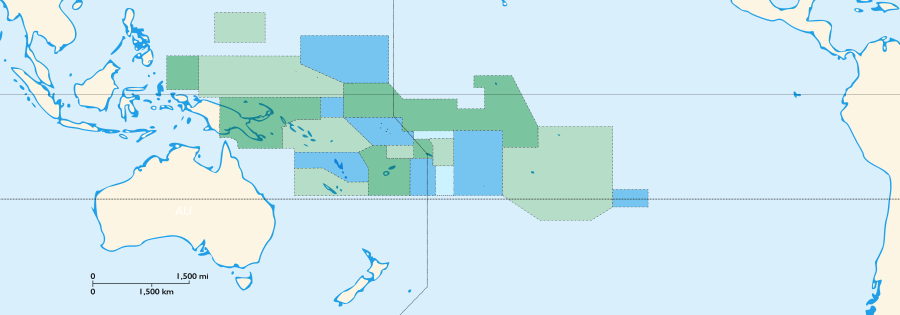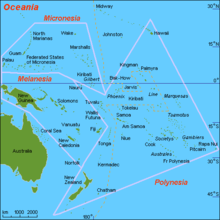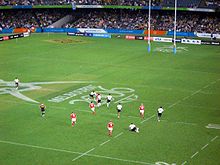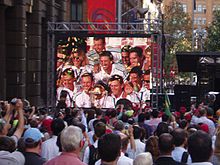
Oceania
About this schools Wikipedia selection
SOS Children made this Wikipedia selection alongside other schools resources. With SOS Children you can choose to sponsor children in over a hundred countries
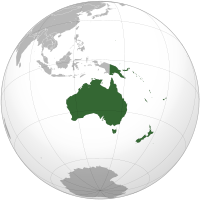 Geopolitical Oceania |
|
| Area | 8,525,989 km2 (3,291,903 sq mi) |
|---|---|
| Population | 35,670,000 |
| Demonym | Oceanic; Oceanian |
| Countries | |
| Dependencies |
|
| Languages | |
| Time Zones | UTC+8 ( Australian Western Standard Time) to UTC-6 (Easter Island) (West to East) |
| Largest cities | Sydney Melbourne Brisbane Perth Auckland Adelaide |
Oceania ( UK pron.: / ˌ ə ʊ ʃ ɪ ˈ ɑː n ɪ ə / or / ˌ ə ʊ s ɪ ˈ ɑː n ɪ ə /; US / ˌ oʊ ʃ iː ˈ æ n iː ə /) is a region centered on the islands of the tropical Pacific Ocean. Opinions of what constitutes Oceania range from the coral atolls and volcanic islands of the South Pacific ( ethnologically divided into the subregions of Melanesia, Micronesia, and Polynesia) to the entire insular region between Asia and the Americas, including Australasia and the Malay Archipelago. The term is sometimes used more specifically to denote a continent comprising Australia and proximate islands, or biogeographically as a synonym for either the Australasian ecozone ( Wallacea and Australasia) or the Pacific ecozone (Melanesia, Polynesia, and Micronesia apart either from New Zealand or from mainland New Guinea).
Etymology
The term was coined as Océanie ca. 1812 by geographer Conrad Malte-Brun. The word Océanie is a French language word derived from the Greek word ὠκεανός (ōkeanós), ocean.
Definitions
As an ecozone, Oceania includes all of Micronesia, Fiji, and all of Polynesia except New Zealand. New Zealand, along with New Guinea and nearby islands, Australia, the Solomon Islands, Vanuatu, and New Caledonia, constitute the separate Australasia ecozone. In geopolitical terms, however, New Zealand, the Solomon Islands, Vanuatu and New Caledonia are almost always considered part of Oceania, and Australia and Papua New Guinea are usually considered part of Oceania too. Sometimes Papua province in Indonesia may be included, as Puncak Jaya is often considered the highest peak in Oceania.
Physiography
Oceania was originally conceived as the lands of the Pacific Ocean, stretching from the Straits of Malacca to the coast of the Americas. It comprised four regions: Polynesia, Micronesia, Malaysia (now called the Malay Archipelago), and Melanesia (now called Australasia). Included are parts of three geological continents, Eurasia, Australia, and Zealandia, as well the non-continental volcanic islands of the Philippines, Wallacea, and the open Pacific. It extends to Sumatra in the west, the Bonin Islands in the northwest, the Hawaiian Islands in the northeast, Rapa Nui and Sala y Gómez Island in the east, and Macquarie Island in the south, but excludes Taiwan, the Japanese Archipelago (including the Ryukyu Islands), and Aleutian Islands of the margins of Asia.
The states that occupy Oceania that are not included in geopolitical Oceania are Indonesia, Malaysia (through Malaysian Borneo), Brunei, the Philippines, and East Timor. The islands of the geographic extremes are politically integral parts of Japan (Bonin), the United States (Hawaii), and Chile (Rapa Nui, formerly Easter Island). A smaller geographic definition also exists, which excludes the land on the Sunda Plate, but includes Indonesian New Guinea as part of the Australian continent.
Biogeography
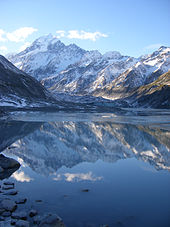
Biogeographically, Oceania is used as a synonym for either the Australasian ecozone ( Wallacea and Australasia) or the Pacific ecozone (Melanesia, Polynesia, and Micronesia apart either from New Zealand or from mainland New Guinea).
Ecogeography
Oceania is one of eight terrestrial ecozones, which constitute the major ecological regions of the planet. The Oceania ecozone includes all of Micronesia, Fiji, and all of Polynesia except New Zealand. New Zealand, New Guinea, Melanesia apart from Fiji, and Australia constitute the separate Australasia ecozone. The Malay Archipelago is part of the Indomalaya ecozone. Related to these concepts are Near Oceania, that part of western Island Melanesia which has been inhabited for tens of millennia, and Remote Oceania, which is more recently settled.
Geopolitics
In the geopolitical conception used by the United Nations, International Olympic Committee, and many atlases, Oceania includes Australia and the nations of the Pacific from Papua New Guinea east, but not the Malay Archipelago or Indonesian New Guinea.
Other definitions
- The term is often used to denote a continent comprising Australia and proximate islands.
- New Zealand forms the south-western corner of the Polynesian Triangle. Its indigenous Māori constitute one of the major cultures of Polynesia. It is also, however, considered part of Australasia.
- The widest definition of Oceania includes the entire region between continental Asia and the Americas, thereby including islands in the Pacific Rim such as the Japanese Archipelago, Taiwan, and the Aleutian islands.
History
See History of Oceania, History of the Pacific Islands
Demographics
Oceania
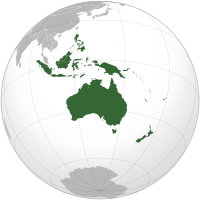
Wider Geographic Oceania.
Little of the South Pacific is apparent at this scale, though Hawaii is just visible near the eastern horizon.
| Area | 10,975,600 km2 (4,237,700 sq mi) |
|---|---|
| Population | 37.8 million (2010) |
| Time Zones | UTC+7 ( Western Indonesian Time) to UTC-6 (Easter Island) |
| Largest Cities | Jakarta Manila Sydney Bandung Melbourne Surabaya Medan |
| Area | 183,000 km2 (71,000 sq mi) |
|---|---|
| Population | 5.2 million (2008) |
| Time Zones | UTC+9 (Palau) to UTC-6 (Easter Island) |
| Largest Cities | Honolulu Nouméa Suva Papeete Honiara |
The demographic table below shows the subregions and countries of geopolitical Oceania. The countries and territories in this table are categorized according to the scheme for geographic subregions used by the United Nations. The information shown follows sources in cross-referenced articles; where sources differ, provisos have been clearly indicated. These territories and regions are subject to various additional categorisations, of course, depending on the source and purpose of each description.
| Name of region, followed by countries and their flags |
Area (km²) |
Population | Population density (per km²) |
Capital | ISO 3166-1 |
|---|---|---|---|---|---|
| Australasia | |||||
| 7,686,850 | 22,028,000 | 2.7 | Canberra | AU | |
| 268,680 | 4,108,037 | 14.5 | Wellington | NZ | |
| External territories of Australia: | |||||
| Ashmore and Cartier Islands | 199 | ||||
| 135 | 1,493 | 3.5 | Flying Fish Cove | CX | |
| 14 | 628 | 45.1 | West Island | CC | |
| Coral Sea Islands | 10 | 4 | |||
| Heard Island and McDonald Islands | 372 | HM | |||
| 35 | 2,302 | 61.9 | Kingston | NF | |
| Melanesia | |||||
| 18,270 | 856,346 | 46.9 | Suva | FJ | |
| 19,060 | 240,390 | 12.6 | Nouméa | NC | |
| 462,840 | 5,172,033 | 11.2 | Port Moresby | PG | |
| 28,450 | 494,786 | 17.4 | Honiara | SB | |
| 12,200 | 240,000 | 19.7 | Port Vila | VU | |
| Micronesia | |||||
| 702 | 135,869 | 193.5 | Palikir | FM | |
| 549 | 160,796 | 292.9 | Hagåtña | GU | |
| 811 | 96,335 | 118.8 | South Tarawa | KI | |
| 181 | 73,630 | 406.8 | Majuro | MH | |
| 21 | 12,329 | 587.1 | Yaren (de facto) | NR | |
| 477 | 77,311 | 162.1 | Saipan | MP | |
| 458 | 19,409 | 42.4 | Melekeok | PW | |
| |
2 | 12 | Wake Island | UM | |
| Polynesia | |||||
| 199 | 68,688 | 345.2 | Pago Pago, Fagatogo | AS | |
| 240 | 20,811 | 86.7 | Avarua | CK | |
| 164 | 3,791 | 23.1 | Hanga Roa | CL | |
| 4,167 | 257,847 | 61.9 | Papeete | PF | |
| 16,636 | 1,360,301 | 81.8 | Honolulu | US | |
| 260 | 2,134 | 8.2 | Alofi | NU | |
| 5 | 47 | 10 | Adamstown | PN | |
| 2,944 | 179,000 | 63.2 | Apia | WS | |
| 10 | 1,431 | 143.1 | Nukunonu | TK | |
| 748 | 106,137 | 141.9 | Nukuʻalofa | TO | |
| 26 | 11,146 | 428.7 | Funafuti | TV | |
| 274 | 15,585 | 56.9 | Mata-Utu | WF | |
| Total | 8,525,989 | 35,669,267 | 4.2 | ||
| Total minus mainland Australia | 839,139 | 13,641,267 | 16.1 | ||
|
NZ
Hawaii
WK
Galápagos
Islands |
|
|
Religion
The predominant religion in Oceania is Christianity. Traditional religions are often animist and prevalent among traditional tribes is the belief in spirits (masalai in Tok Pisin) representing natural forces. In recent Australian and New Zealand censuses, large proportions of the population say they belong to "No religion" (which includes atheism, agnosticism, Secular Humanism, and rationalism). In Tonga, everyday life is heavily influenced by Polynesian traditions and especially by the Christian faith. The Bahá'í House of Worship in Tiapapata, Samoa is one of seven designations administered in the Baha'i faith.
Sport
Pacific Games
The Pacific Games (formerly known as the South Pacific Games) is a multi-sport event, much like the Olympics on a much smaller scale, with participation exclusively from countries around the Pacific. It is held every four years and began in 1963. Australia and New Zealand do not compete at the Pacific Games.
Rugby League
Rugby league is a popular sport throughout Oceania, and is the national sport of Papua New Guinea (the second most populous country in Oceania after Australia) and is very popular in Australia and attracts significant attention across New Zealand and the Pacific Islands.
Australia and New Zealand are two of the most successful sides in the world. Australia has won the Rugby League World Cup a record nine times while New Zealand won their first World Cup in 2008. Australia hosted the second tournament in 1957. Australia and New Zealand jointly hosted it in 1968 and 1977. New Zealand hosted the final for the first time in 1985 – 1988 tournament and Australia hosted the last tournament in 2008.
Rugby Union
Rugby union is one of the region's most prominent sports, and is the national sport of New Zealand, Samoa, Fiji and Tonga. Fiji's sevens team is one of the most successful in the world, as is New Zealand's.
New Zealand and Australia have won the Rugby World Cup a record two times (tied with South Africa who have also won it two times). New Zealand won the inaugural World Cup in 1987. Australia and New Zealand jointly hosted the World Cup in 1987. Australia hosted it in 2003 and New Zealand hosted it in 2011.
Cricket
Cricket is a popular summer sport in Australia and New Zealand. Australia had ruled International cricket as the number one team for more than a decade, and have won four Cricket World Cups and have been runner-up for two times, making them the most successful cricket team. New Zealand is also considered a strong competitor in the sport, with the New Zealand Cricket Team, also called the Black Caps, enjoying success in many competitions. Both Australia and New Zealand are Full members of the ICC. Fiji, Vanuatu and Papua New Guinea are some of the Associate/Affiliate members of the ICC from Oceania that are governed by ICC East Asia-Pacific. Beach Cricket, a greatly simplified variant of cricket played on a sand beach, is also a popular recreational sport in Australia.
Cricket is culturally a significant sport for summer in Oceania. The Boxing Day Test is very popular in Australia, conducted every year on 26 December at the Melbourne Cricket Ground, Melbourne.
Australian rules football
Australian rules football is the national sport in Nauru and is the most popular football code in Australia. It is also popular in Papua New Guinea.
Association football (soccer)
The Oceania Football Confederation (OFC) is one of six association football confederations under the auspices of FIFA, the international governing body of the sport. The OFC is the only confederation without an automatic qualification to the World Cup Finals. Currently the winner of the OFC qualification tournament must play off against an Asian confederation side to qualify for the World Cup.
Currently, Vanuatu is the only country in Oceania to call football (soccer) its national sport.
Oceania has been represented at four World Cup finals tournaments — Australia in 1974, 2006 and 2010, and New Zealand in 1982 and 2010. In 2006, Australia joined the Asian Football Confederation and qualified for the 2010 World cup as an Asian entrant. New Zealand qualified through the Oceania Confederation, winning its playoff against Bahrain. 2010 was the first time two countries from Oceania had qualified at the same time, albeit through different confederations.
